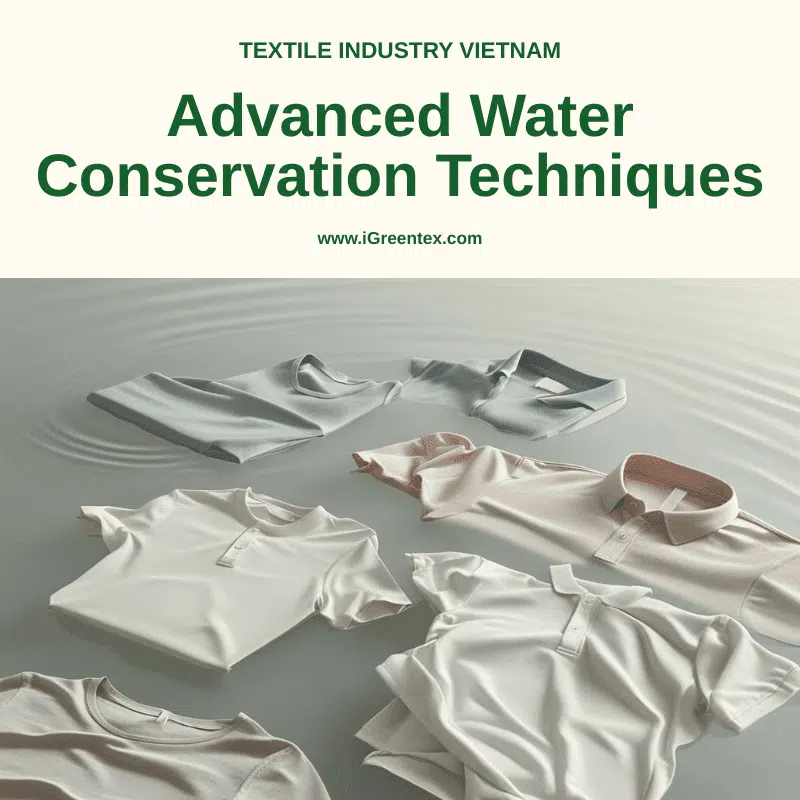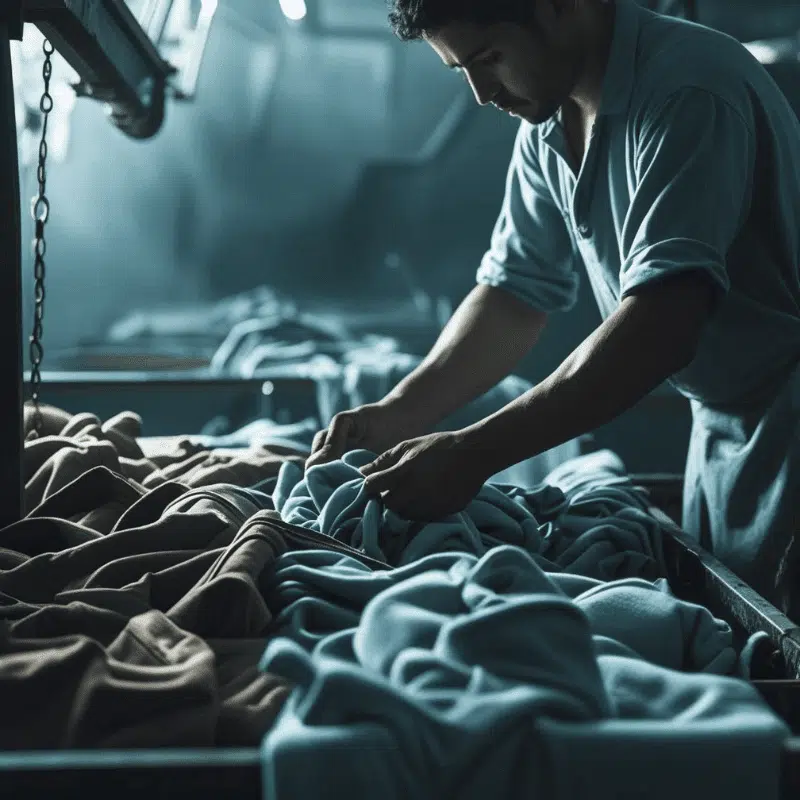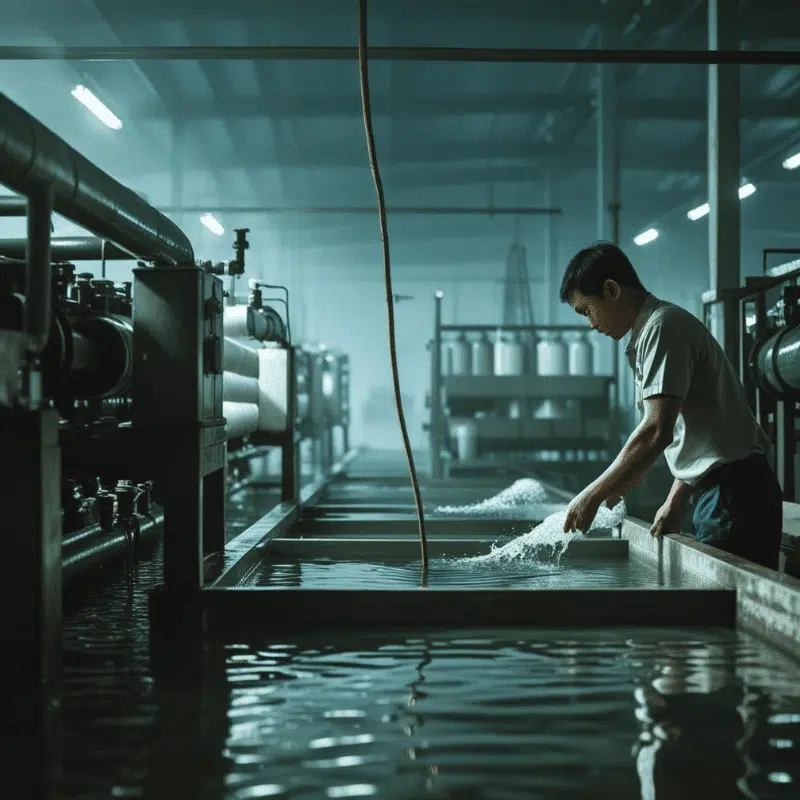- Every Drop Counts: Advanced Water Conservation Techniques in Vietnam’s Textile Industry and iGreen Tex Factory
- The Water Challenge: Understanding Vietnam’s Textile Industry Context
- Advanced Water Conservation Techniques: Technical Solutions for Vietnamese Factories
- iGreen Tex’s Collaborative Approach to Water Conservation
- Economic Benefits and Implementation Considerations
- Communication and Transparency in Water Conservation
- Future Outlook and Technological Developments
- Regional Water Conservation Success Stories
- Conclusion: Partnership for Sustainable Water Management
- About IGREEN TEX
- IGREEN TEX VIETNAM CO LTD
Every Drop Counts: Advanced Water Conservation Techniques in Vietnam’s Textile Industry and iGreen Tex Factory
The textile manufacturing sector consumes approximately 2,700 liters of water to produce a single cotton t-shirt. This staggering figure represents just one garment from billions manufactured annually. Vietnam’s textile industry, a cornerstone of the nation’s economy, faces mounting pressure to address its water consumption patterns. Factory managers and sustainability specialists recognize that implementing effective water conservation techniques in textile industry vietnam has become essential for operational viability and environmental responsibility.

Water scarcity affects manufacturing regions across Vietnam, with industrial zones competing for limited freshwater resources. Rising utility costs, stricter environmental regulations, and international buyer requirements create a compelling case for adopting advanced water management strategies. The challenge extends beyond simple conservation—it requires systematic implementation of proven water conservation techniques in textile industry vietnam that deliver measurable results.
See more: Vietnam Apparel Production Scalability for Streetwear Brand
See more: Ethical Streetwear Production Vietnam
See more: Vietnam’s Textile Innovation Hubs for Streetwear Development
See more: Risk Mitigation Strategies for Manufacturing Streetwear
See more: Quality Assurance Benchmarks for Vietnamese-Made Streetwear
See more: How to Build Partnerships Vietnamese Apparel Factories
The Water Challenge: Understanding Vietnam’s Textile Industry Context
Vietnam’s textile sector processes over 4 billion garments annually, ranking among the world’s top apparel exporters. Each production cycle—from fiber preparation through dyeing, printing, and finishing—demands substantial water volumes. Traditional manufacturing methods consume 150-200 liters of water per kilogram of finished fabric, creating significant environmental and economic pressures.

Local water resources face increasing strain from industrial demand, agricultural needs, and urban development. Groundwater depletion in key manufacturing provinces forces factories to seek alternative sources at higher costs. Wastewater treatment requirements add operational complexity, with discharge standards becoming progressively stringent. These factors drive the urgent need for practical water conservation techniques in textile industry vietnam.
The economic implications are substantial. Water costs represent 8-15% of total production expenses in Vietnamese textile facilities. Effective conservation measures can reduce these costs by 30-50%, improving profit margins while meeting sustainability objectives. Implementation of proven water conservation techniques in textile industry vietnam generates both immediate savings and long-term competitive advantages.
Advanced Water Conservation Techniques: Technical Solutions for Vietnamese Factories
1. Revolutionary Dyeing Technologies
Modern dyeing processes offer the greatest potential for water reduction in textile manufacturing. Advanced equipment and methods can cut water consumption by 40-70% compared to conventional techniques.
Low-Liquor Ratio Dyeing Systems represent the most accessible upgrade for existing facilities. These machines operate with liquor ratios of 1:6 to 1:8, compared to traditional ratios of 1:12 to 1:15. The technology reduces water consumption by 35-50% while maintaining color quality and consistency. Vietnamese manufacturers report payback periods of 18-24 months through reduced water, energy, and chemical costs.
Dope Dyeing Technology eliminates water usage entirely for synthetic fiber coloration. This process adds colorants to polymer solutions before fiber extrusion, creating permanently colored fibers. Vietnamese polyester manufacturers using dope dyeing report 95% water reduction compared to conventional dyeing methods. The technique works particularly well for staple colors in athletic wear and basic apparel lines.
Supercritical CO2 Dyeing represents the cutting edge of waterless coloration. This technology uses carbon dioxide in a supercritical state as the dyeing medium, completely eliminating water from the process. While initial investment costs are high, the technology offers zero water consumption and 100% CO2 recycling. Early adopters in Vietnam’s high-end manufacturing sector report excellent results with synthetic fabrics.
2. Process Optimization Strategies
Systematic optimization of wet processing steps can achieve 20-40% water savings without major equipment investments. These water conservation techniques in textile industry vietnam focus on operational efficiency improvements.

Combined Processing Techniques merge multiple wet treatment steps into single baths. For example, combining scouring and bleaching operations reduces water consumption by eliminating intermediate rinses. Vietnamese cotton processors report 30% water savings through optimized process sequences. The approach requires careful chemical balance but delivers immediate results.
Enzymatic Treatment Systems replace harsh chemical processes with biological alternatives. Enzymatic desizing, bio-polishing, and cellulase treatments operate at lower temperatures with reduced rinsing requirements. These methods cut water usage by 25-35% while improving fabric quality. Vietnamese denim manufacturers particularly benefit from enzymatic washing processes that create desired effects with minimal water consumption.
Counter-current Rinsing Systems optimize water usage during cleaning operations. Fresh water enters at the final rinse stage, flowing backward through preceding stages. This technique reduces water consumption by 50-60% while maintaining cleaning effectiveness. Implementation requires minimal investment but careful process control to ensure quality standards.
3. Water Recycling and Reuse Technologies
Closed-loop water systems represent the most comprehensive approach to conservation. These technologies treat and reuse wastewater within manufacturing facilities, dramatically reducing freshwater demand.

Membrane Bioreactor (MBR) Systems combine biological treatment with membrane filtration to produce high-quality reclaimed water. Vietnamese facilities using MBR technology report 60-80% reduction in freshwater consumption. The treated water meets quality standards for dyeing auxiliaries, equipment cooling, and initial washing processes.
Zero Liquid Discharge (ZLD) Systems eliminate wastewater discharge entirely through advanced treatment and recovery processes. These systems recover 95-98% of process water as reusable resources. While investment costs are significant, ZLD technology offers complete water independence and eliminates discharge permit requirements. Vietnamese manufacturers in water-stressed regions increasingly adopt ZLD systems for long-term sustainability.
Selective Water Recycling targets specific process streams for treatment and reuse. Hot water from dyeing operations can be recovered for subsequent washing steps after basic filtration. Rinse water from final stages can be reused for initial washing processes. These selective approaches achieve 30-50% water savings with moderate investment requirements.
iGreen Tex’s Collaborative Approach to Water Conservation
iGreen Tex Vietnam recognizes that effective water management requires industry-wide collaboration. Our commitment to advancing water conservation techniques in textile industry vietnam extends beyond our direct operations to encompass our entire partner network.
Technical Assessment and Planning
Our approach begins with comprehensive water audits at partner facilities. These assessments identify current consumption patterns, inefficiencies, and improvement opportunities. We evaluate existing equipment, process flows, and operational practices to develop tailored conservation strategies. This systematic approach ensures that recommended water conservation techniques in textile industry vietnam align with specific facility capabilities and constraints.
The assessment process examines water usage across all production stages, from fiber preparation through finishing operations. We analyze consumption data, identify peak usage periods, and evaluate treatment system performance. This detailed evaluation forms the foundation for implementing effective water conservation techniques in textile industry vietnam that deliver measurable results.
Technology Transfer and Implementation Support
iGreen Tex facilitates technology transfer by connecting partners with proven water conservation solutions. We provide technical guidance on equipment selection, installation planning, and operational optimization. Our support extends to training programs that ensure proper implementation of new water conservation techniques in textile industry vietnam.
We maintain relationships with technology providers, equipment manufacturers, and engineering consultants to offer comprehensive implementation support. This network enables partners to access cutting-edge water conservation techniques in textile industry vietnam while minimizing implementation risks and costs.
Material Selection and Process Design
Our involvement in material selection directly impacts water consumption throughout the supply chain. By recommending fabrics that require minimal wet processing, we help reduce overall water demand. This proactive approach to choosing sustainable fabrics for apparel brands considers both environmental impact and production efficiency.
We work with brands to identify fiber types, fabric constructions, and finishing requirements that minimize water consumption. Pre-treated fabrics, solution-dyed materials, and mechanically finished textiles can significantly reduce water usage compared to conventional alternatives. This strategic approach integrates water conservation techniques in textile industry vietnam from the earliest design stages.
Performance Monitoring and Continuous Improvement
Effective water conservation requires ongoing monitoring and optimization. We help partners establish measurement systems that track water consumption, efficiency metrics, and cost savings. Regular performance reviews identify additional improvement opportunities and ensure sustained benefits from implemented water conservation techniques in textile industry vietnam.
Our monitoring approach includes benchmarking against industry standards, tracking regulatory compliance, and measuring environmental impact reductions. This data-driven methodology demonstrates the value of water conservation techniques in textile industry vietnam while supporting continuous improvement efforts.
Economic Benefits and Implementation Considerations
The business case for sustainable fashion manufacturing becomes compelling when examining water conservation economics. Vietnamese textile facilities implementing comprehensive water conservation techniques in textile industry vietnam report 25-45% reduction in water-related operating costs. These savings result from reduced consumption, lower treatment costs, and improved operational efficiency.
Capital investment requirements vary significantly based on chosen technologies and implementation scope. Basic optimization measures require minimal investment but deliver immediate returns. Advanced recycling systems involve substantial capital costs but offer long-term strategic advantages. Most facilities adopt phased implementation approaches that balance investment capacity with conservation objectives.
Overcoming Implementation Challenges
Overcoming challenges in implementing ethical apparel production requires addressing technical, financial, and operational barriers. Water conservation initiatives face similar obstacles, including equipment costs, technical complexity, and operational disruption concerns.
Technical challenges include equipment integration, process optimization, and quality control maintenance. Financial barriers involve capital investment requirements, uncertain payback periods, and competing priority investments. Operational concerns focus on production disruption, staff training needs, and performance reliability.
iGreen Tex addresses these challenges through comprehensive support services, phased implementation strategies, and risk mitigation approaches. Our experience with water conservation techniques in textile industry vietnam enables us to guide partners through successful implementation processes while minimizing disruption and maximizing benefits.
Quality Assurance and Standards Compliance
Implementing water conservation techniques in textile industry vietnam must not compromise product quality or regulatory compliance. Our approach emphasizes maintaining fabric properties, color consistency, and durability standards while achieving water savings objectives.
We work with partners to establish quality control protocols that ensure conservation measures enhance rather than compromise product performance. This includes testing programs, process validation, and continuous monitoring systems that verify quality standards throughout implementation of water conservation techniques in textile industry vietnam.
Communication and Transparency in Water Conservation
Effective marketing sustainable fashion to conscious consumers requires authentic communication about water conservation efforts. Brands increasingly demand transparency about manufacturing practices, including water usage and conservation measures. This creates opportunities for facilities implementing water conservation techniques in textile industry vietnam to differentiate themselves in competitive markets.
We support partners in documenting and communicating their water conservation achievements. This includes developing performance metrics, creating sustainability reports, and obtaining third-party verification of conservation claims. These efforts strengthen the transparent sustainable supply chain for global streetwear brands vietnam while building consumer trust.
Building Market Advantage Through Water Stewardship
Water conservation capabilities increasingly influence sourcing decisions by international brands. Facilities demonstrating effective water conservation techniques in textile industry vietnam gain competitive advantages in contract negotiations and long-term partnerships. This market recognition creates additional economic incentives for conservation investments.
Our partners report that water conservation capabilities enhance their reputation with environmentally conscious brands and consumers. This positioning supports premium pricing opportunities and strengthens customer relationships based on shared sustainability values.
Future Outlook and Technological Developments
The evolution of water conservation techniques in textile industry vietnam continues accelerating through technological innovation and regulatory pressures. Emerging technologies promise even greater water savings potential, including advanced membrane systems, AI-optimized processes, and closed-loop manufacturing systems.
Digital technologies enable real-time monitoring and optimization of water usage patterns. Smart sensors, data analytics, and automated control systems optimize water conservation techniques in textile industry vietnam through continuous process adjustment and efficiency improvements.
Regulatory Trends and Market Drivers
Vietnam’s environmental regulations continue strengthening, with stricter discharge standards and water usage restrictions in industrial zones. These regulatory trends create additional incentives for implementing comprehensive water conservation techniques in textile industry vietnam.
International trade agreements and buyer requirements increasingly emphasize environmental performance standards. Facilities demonstrating effective water conservation gain access to premium market segments and long-term contract opportunities. This regulatory and market alignment supports continued investment in water conservation techniques in textile industry vietnam.
Regional Water Conservation Success Stories
Several Vietnamese textile facilities have already demonstrated remarkable success with water conservation techniques in textile industry vietnam. A polyester manufacturer in Dong Nai province reduced water consumption by 65% through dope dyeing technology implementation. The facility now processes 2,000 tons monthly while using 40% less water than traditional methods.
In Ho Chi Minh City’s textile district, a denim finishing plant achieved 55% water savings through combined MBR systems and counter-current rinsing. The facility treats and reuses 800 cubic meters daily, eliminating freshwater dependency for non-critical processes. Monthly water costs decreased by 45%, generating annual savings exceeding $180,000.
These success stories highlight the practical benefits of water conservation techniques in textile industry vietnam. Factory managers report improved operational efficiency alongside environmental gains. Reduced water heating costs, lower chemical consumption, and decreased wastewater treatment expenses create multiple value streams. Equipment reliability improves due to reduced scaling and corrosion from recycled water systems.
Worker safety benefits also emerge from implementing water conservation techniques in textile industry vietnam. Reduced chemical handling, lower steam generation, and improved ventilation systems create healthier working environments. Training programs for new conservation technologies enhance workforce skills and career development opportunities.
The regional success demonstrates that water conservation techniques in textile industry vietnam are not theoretical concepts but proven strategies delivering measurable results. These examples inspire broader industry adoption while providing practical implementation guidance for facilities considering similar investments in sustainable manufacturing practices.
Conclusion: Partnership for Sustainable Water Management
Water conservation in Vietnam’s textile industry requires collaborative effort across the entire value chain. From fiber producers through garment manufacturers to international brands, all stakeholders must commit to implementing effective water conservation techniques in textile industry vietnam.
iGreen Tex Vietnam’s approach emphasizes partnership, technical support, and continuous improvement. We recognize that sustainable water management benefits all participants through cost savings, regulatory compliance, and market differentiation. Our commitment to advancing water conservation techniques in textile industry vietnam reflects our broader mission of building a more sustainable apparel industry.
The challenges facing Vietnam’s textile industry are significant, but the solutions are within reach. Through systematic implementation of proven water conservation techniques in textile industry vietnam, the industry can achieve substantial environmental improvements while maintaining economic competitiveness.
We invite manufacturers, brands, and industry partners to join us in this critical initiative. Together, we can transform Vietnam’s textile industry into a model of sustainable water management while continuing to serve global apparel markets effectively. Contact iGreen Tex Vietnam to discuss how we can support your water conservation objectives and contribute to a more sustainable future for textile manufacturing.
The path forward requires commitment, investment, and collaboration. But the benefits—environmental protection, cost savings, and competitive advantage—make implementation of water conservation techniques in textile industry vietnam an essential strategy for long-term success in Vietnam’s dynamic textile sector.
About IGREEN TEX
IGREEN TEX is a provider of fashion and textile products, offering a wide range of both domestically and internationally. Our commitment to quality ensures that our products not only meet the highest standards but also promote eco-friendly practices, in Vietnam sportswear manufacturing.
If you want to read more information about canvas bags, and if you want to tote bags at Tphcm, you can see it here!!!
To view product information click here
Visit our website to learn more about our products and services: IGREEN TEX
IGREEN TEX VIETNAM CO LTD
Address: No. 6 – 6A, D52 Street, Ward Bay Hien, HCMC
E-mail: info@igreentex.com
WhatsApp/Viber/Zalo: +84 938.045.900